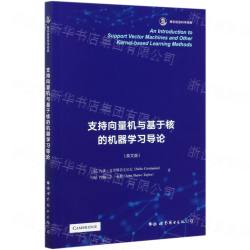-
内容大纲
支持向量机(Support Vector Machine,SVM)是建立在弗拉基米尔·万普尼克(Vladimir Vapnik)提出的统计学习理论基础上的一种使用广泛的机器学习方法。这本简明导论教程对支持向量机及其理论基础进行了全面的介绍。书中从机器学习方法论讲到到超平面、核函数、泛化理论、优化理论,最后总结到支持向量机理论,并介绍了其实现技术及应用。本书的叙述循序渐进,内容深入浅出,既严谨又易于理解。书中清晰的条理、富于逻辑性的推导以及优美的文字,备受初学者和专家的赞许。本书可作为计算机、自动化、电子工程、应用数学等专业的高年级本科生或研究生教材,也可作为机器学习、人工智能、神经网络、数据挖掘等课程的参考教材,同时还是相关领域的教师和研究人员的参考书。 -
作者介绍
-
目录
Preface
Notation
1 The Learning Methodology
1.1 Supervised Learning
1.2 Learning and Generalisation
1.3 Improving Generalisation
1.4 Attractions and Drawbacks of Learning
1.5 Support Vector Machines for Learning
1.6 Exercises
1.7 Further Reading and Advanced Topics
2 Linear Learning Machines
2.1 Linear Classification
2.1.1 Rosenblatt's Perceptron
2.1.2 Other Linear Classmers
2.1.3 Multi-class Discfimination
2.2 Linear Regression
2.2.1 Least Squares
2.2.2 Ridge Regression
2.3 Dual Representation of Linear Machines
2.4 Exercises
2.5 Further Reading and Advanced Topics
3 Kernel-Induced Fleature Spaces
3.1 Learning jn Feature Space
3.2 The Implicit Mapping into Feature Space
3.3 Making Kernels
3.3.1 Characterisation of Kernels
3.3.2 Making Kernels from Kernels
3.3.3 Making Kernels from Features
3.4 Working in Feature Space
3.5 Kernels and Gaussian Processes
3.6 Exercises
3.7 Further Reading and Advanced Topics
4 Generalisation Theory
4.1 Probably Approximately Correct Learning
4.2 Vapnik Chenronenkis (VC) Theory
4.3 Margin-Based Bounds on Generalisation
4.3.1 Maximal Margin Bounds
4.3.2 Margin Percentile Bounds
4.3.3 Soft Margin Bounds
4.4 Other Bounds on Generalisation and Luckiness
4.5 Generalisation for Regression
4.6 Bayesian Analysis of Learning
4.7 Exercises
4.8 Further Reading and Advanced Topics
5 Optimisation Theory
5.1 Problem Formulation
5.2 Lagrangian Theory
5.3 Duality
5.4 Exercises
5.5 Further Reading and Advanced Topics
6 Support Vector Machines
6.1 Support Vector Classification
6.1.1 The Maximal Margin Classifier
6.1.2 Soft Margin Optimisation
6.1.3 Linear Programming Support Vector Machines
6.2 Support Vector Regression
6.2.1 ε-Insensitive Loss Regression
6.2.2 Kernel Ridge Regression
6.2.3 Gaussian Processes
6.3 Discussion
6.4 Exercises
6.5 Further Reading and Advanced Topics
7 Implementation Techniques
7.1 General Issues
7.2 The Naive Solution: Gradient Ascent
7.3 General Techniques and Packages
7.4 Chunking and Decomposition
7.5 Sequential Minimal Optimisation (SMO)
7.5.1 Analvtical Solution for Two Points
7.5.2 Selection Heuristics
7.6 Techniaues for Gaussian Processes
7.7 Exercises
7.8 Further Reading and Advanced Topics
8 Applications of Support Vector Machines
8.1 Text Categorisation
8.1.1 A Kernel from IR Applied to Information Filtering
8.2 Image Recognition
8.2.1 Aspect Independent Classification
8.2.2 Colour-Based Classification
8.3 Hand-written Digit Recognition
8.4 Bioinformatics
8.4.1 Protein Homology Detection
8.4.2 Gene Expression
8.5 Further Reading and Advanced Topics
A Pseudocode for the SMO Algorithm
B Background Mathematics
B.1 vector Spaces
B.2 Inner Product Spaces
B.3 Hilbert Spaces
B.4 Operators, Eigenvalues and Eigenvectors
References
Index
同类热销排行榜
- C语言与程序设计教程(高等学校计算机类十二五规划教材)16
- 电机与拖动基础(教育部高等学校自动化专业教学指导分委员会规划工程应用型自动化专业系列教材)13.48
- 传感器与检测技术(第2版高职高专电子信息类系列教材)13.6
- ASP.NET项目开发实战(高职高专计算机项目任务驱动模式教材)15.2
- Access数据库实用教程(第2版十二五职业教育国家规划教材)14.72
- 信号与系统(第3版下普通高等教育九五国家级重点教材)15.08
- 电气控制与PLC(普通高等教育十二五电气信息类规划教材)17.2
- 数字电子技术基础(第2版)17.36
- VB程序设计及应用(第3版十二五职业教育国家规划教材)14.32
- Java Web从入门到精通(附光盘)/软件开发视频大讲堂27.92
推荐书目
-

孩子你慢慢来/人生三书 华人世界率性犀利的一枝笔,龙应台独家授权《孩子你慢慢来》20周年经典新版。她的《...
-

时间简史(插图版) 相对论、黑洞、弯曲空间……这些词给我们的感觉是艰深、晦涩、难以理解而且与我们的...
-

本质(精) 改革开放40年,恰如一部四部曲的年代大戏。技术突变、产品迭代、产业升级、资本对接...

 [
[
